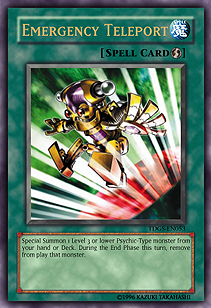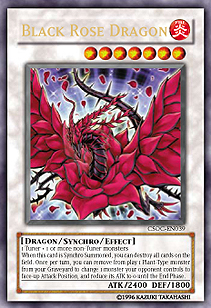 It’s become pretty obvious that TeleDAD can end games extremely quickly in this format. Being able to put over 4000 ATK on the field that can protect itself for a turn and destroy everything the opponent has by next turn means you can win the game in two turns. It was the application of this strategy that led to the original Overdose build of TeleDAD. That build has, for the most part, become the framework for TeleDAD decks to come.
It’s become pretty obvious that TeleDAD can end games extremely quickly in this format. Being able to put over 4000 ATK on the field that can protect itself for a turn and destroy everything the opponent has by next turn means you can win the game in two turns. It was the application of this strategy that led to the original Overdose build of TeleDAD. That build has, for the most part, become the framework for TeleDAD decks to come.
Remember, in the first tournament TeleDAD ever entered, it didn’t win. Despite taking eleven of the Top 16 spots, it was a Gladiator Beast deck that eventually came out on top. The reason was that matchups in the Top 16 often don’t pan out the way they would in Swiss. Everyone seems to play more cautiously on Day 2 because one loss means elimination from the tournament. Furthermore, the respect for the opponent’s skill is greater on Day 2, and as such, people expect their opponents to be better at countering their moves. They’ll be less likely to make aggressive pushes.
That doesn’t do anything good for TeleDAD. TeleDAD needed to work in two turns to be really effective. Slow-rolling TeleDAD meant drawing cards that couldn’t really be used later on. TeleDAD players were punished for this playstyle, which helped Gladiator Beasts take the tournament. But Gladiator Beasts didn’t win ever again. TeleDAD players had more time with the deck after Shonen Jump Championship Baltimore and realized it draws poorly in the late game.
So their strategy now is to make the game end as quickly as possible. The worst-case scenario is they lose in the early game. Since making it to the late game is as good as losing anyway, losing in the early game isn’t much worse. And if you build your deck toward achieving this end you’ll find it’s not an unreasonable strategy. TeleDAD can win convincingly and relatively easily within the first couple turns.
What’s the point of all this? I believe there’s a new strategy available that has never been a winning game plan before. Playing against TeleDAD, you can actually play just to lengthen the game. You should always be playing to win the game, looking at how the duel is going to break down and making sure that you’re on the winning side. But now if TeleDAD is always on the losing side in the late game, you can consider "reaching the late game" as good as winning. Sounds good, right?
Of course, the strategy is not as simple as that. You can’t reach the late game with no cards staring down a bunch of Synchros and expect to win. But there’s a card that’s going to let you do it. Black Rose Dragon was expected to be one of the breakout cards for Zombie players and Teleport OTKs in general. The idea was that you would use Black Rose to bomb the field and then special summon enough ATK points for game. Unfortunately players quickly realized that this could only win reliably with Card of Safe Return, and the strategy (along with Rose Dragon) was put aside.
That is until Steven Harris won SJC Detroit with a TeleDAD deck that used Black Rose Dragon as a vital part of his strategy. Remember before how I said that players on Day 2 tend to respect their opponents enough to play slowly and how that would have changed after Baltimore? Steven Harris’s deck doesn’t count. Picture having to play Harris in Day 2 with a TeleDAD deck. Harris has more ways to prevent an OTK than any other TeleDAD deck previously. You’re pretty much forced to respect the possibility of Gorz the Emissary of Darkness, Scapegoat, and Necro Gardna.
 So ultimately other TeleDAD players are forced into a control game that’s going to go deep into each duel. Harris has compensated for the fact that he will be hitting the late game by removing a lot of dead draws from his deck. He plays more live monsters than most people could fit in their builds, and you saw the eventual results in Detroit. He won the tournament, out-drawing his final two opponents in lengthy featured matches.
So ultimately other TeleDAD players are forced into a control game that’s going to go deep into each duel. Harris has compensated for the fact that he will be hitting the late game by removing a lot of dead draws from his deck. He plays more live monsters than most people could fit in their builds, and you saw the eventual results in Detroit. He won the tournament, out-drawing his final two opponents in lengthy featured matches.
But look at who else did well that tournament. Calvin Tsang’s deck played out in a similar fashion. Instead of using Black Rose Dragon to solve mid-game problems and force a late-game scenario, Calvin used a bunch of different normal spells. Lightning Vortex, Prometheus, King of the Shadows, and Reckless Greed are just a few of the extra cards Calvin runs that beef up the late game.
And the other decks that saw Day 2 success? Gadgets and Gladiator Beasts that slowed the game down with Thunder King Rai-Oh and a symphony of protective spells and traps. Even Rob Cedar’s Lightsworn deck utilized Anti-Spell Fragrance along with Lyla, Lightsworn Sorceress and Celestia, Lightsworn Angel to break up OTKs before they could happen. That meant TeleDAD players couldn’t OTK and would be forced into a long duel with Cedar’s Lightsworn, a winning strategy for him.
With Gorz the Emissary of Darkness bopping around and Necro Gardna/Phoenix Wing Wind Blast at three copies per deck it’s very likely that we’ll see the metagame shift toward a more slow-paced equilibrium. What remains to be seen is which deck can most effectively bring TeleDAD to an unpleasant late game.
—Matt Peddle